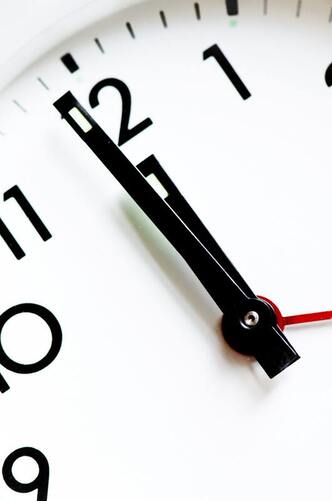The clock is ticking. Are you becoming the person you want to be? It’s January 1st and you haven’t thought about exercise or nutrition for two weeks. You have been eating a lot more than usual, drinking a lot more than usual – and I don’t mean water – and sitting around a lot more than usual. Maybe you feel bloated or sluggish and you think it’s time to “get back on track.” How do you do it? In this article, I intend to cover some strategies to incorporate healthy eating and exercise back into your life after a “holiday layoff.” Nutrition
1. Drink more water. Restaurant meals and party foods contain on average more sodium and less produce than your usual home-cooked meals. Moreover, when you have a lot of social events on your calendar and you aren’t exercising as much, you may not feel thirsty and let your average fluid intake drop to the bare minimum. All of these factors combined may instil a sense of lethargy and brain fog that makes it even harder to return to your fitness routine. Furthermore, drinking more water requires less planning and effort than hitting the gym and managing your food intake. As it is a relatively simple objective to reach, the success will give you confidence and momentum to chase heftier goals. Moreover, progress is easy to track and quantify. All you need is a bottle. Start with at least half a bottle and aim to increase your daily total on a regular basis. 2. Don’t diet. Eating to achieve fat loss or muscle gain is unlikely to bring about positive results if you have been taking some time off flexible dieting. Instead, ease yourself into tracking food intake by taking a couple of weeks to establish your maintenance calories. This will accomplish the following: (a) You will re-learn how to log food and drinks effectively. (b) You will avoid the stress arising from gaining or losing weight. This is a great strategy to get back into the flexible dieting mindset without any of the negative consequences of a prolonged period spent in a state of energy imbalance. When do you start your diet, though? Give yourself at least a couple of weeks to find your rhythm, then start whenever you feel like you have a good handle on tracking, what your maintenance calories look like, and what you need to do to achieve your fitness goals. Training 1. Less is more. Picking up where you left off before your layoff can result in excessive fatigue at best and injury at worst. Although a short period of detraining is unlikely to compromise the strength you previously gained, your technique will be a bit rusty and your capacity to endure the same volume as before might be reduced by the lack of practice. For these reasons, start with a lighter program than the one you were following before. One third of your previous volume and 20 to 30% of the load you were lifting for the same number of reps can be a good place to start for the first week. As an example, let’s say you were doing a four-day upper and lower body split routine, with 12 sets per muscle group per week. The first week, you could do eight sets per muscle or muscle group divided between two to three days of full-body training. This might seem like a deload week for the previous training program and might not be very fatiguing. That’s fine. Your goal for the week is to ease yourself into training so that your next weeks will be productive, not to attempt a new deadlift PR. You can then add one set per muscle or muscle group every week or every other week, depending on how you feel. You may want to keep the load on the bar relatively light for the first week or two, until you feel confident about your form and strength. Performance, not heavy loads, will be your priority in this phase. 2. Program a strength phase. Following on from the previous point, given that you may not be able to sustain high-volume hypertrophy training right away, it would make sense to focus on a different goal for your first mesocycle. Strength can be maintained even during a few weeks of de-training, therefore a strength-oriented mesocycle can have a number of benefits: (a) You can measure the return or increase of your strength by looking at whether you are putting more load on the bar or doing more reps with the same weight over time. (b) The lower volume required during a strength phase will help you get used to training again and pave the way to a successful hypertrophy phase in the future. If, like me, your primary outcome of interest is increased muscularity, then you may want to keep this strength phase short and sweet. Three to four weeks of strength-oriented training is a good target, followed by a one-week deload and your first hypertrophy mesocycle after that. Enjoy the gains! In Future Episodes: In the next article I will lay down some ways to adapt meal prep to your lifestyle. Your Turn: What’s your fitness plan for the new year?
0 Comments
Your comment will be posted after it is approved.
Leave a Reply. |
Nikias TomasielloWelcome to my blog. I’m an online fitness coach with a passion for bodybuilding, fantasy, and bread. Want to work with me? Check out my services!Archives
May 2024
Tags
All
|
Follow me on social media |
Get in touch |
© 2018-2023 Veronica Tomasiello, known as Nikias Tomasiello – All rights reserved


 RSS Feed
RSS Feed